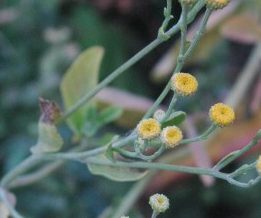 Costmary is a herbaceous perennial native to the Mediterranean and also known as alecost, balsam herb, bible leaf, and mint geranium. It is a member of the aster family, Asteraceae, that also includes daisy, yarrow, and lettuce and may be the plant that the ancient Roman Columella described balsamita in 70 AD. The plant grows up to 6.6′ tall and has oval gray-green leaves with serrated margins and two small lobes at the base of some leaves. Lower leaves are up to 12″ long while upper ones are 1.5-5″ long. They dry well and have a eucalyptus fragrance. In late summer, loose terminal clusters of yellow button-like flowerheads appear that are 1.2″ across. Plants are no longer as popular as they once were but are suitable for an herb garden where they make a good hedge. The leaves are used to flavor beverages, cold soups, and fruit salads. The genus name, Tanacetum, comes from the Greek word athenasia, meaning immortality because of its use in funeral winding sheets to discourage worms. The specific epithet, balsamita, is from the Latin word balsamum, referring to the resinous gum of the balsam tree, and by extension to fragrant leaves of this plant.
Costmary is a herbaceous perennial native to the Mediterranean and also known as alecost, balsam herb, bible leaf, and mint geranium. It is a member of the aster family, Asteraceae, that also includes daisy, yarrow, and lettuce and may be the plant that the ancient Roman Columella described balsamita in 70 AD. The plant grows up to 6.6′ tall and has oval gray-green leaves with serrated margins and two small lobes at the base of some leaves. Lower leaves are up to 12″ long while upper ones are 1.5-5″ long. They dry well and have a eucalyptus fragrance. In late summer, loose terminal clusters of yellow button-like flowerheads appear that are 1.2″ across. Plants are no longer as popular as they once were but are suitable for an herb garden where they make a good hedge. The leaves are used to flavor beverages, cold soups, and fruit salads. The genus name, Tanacetum, comes from the Greek word athenasia, meaning immortality because of its use in funeral winding sheets to discourage worms. The specific epithet, balsamita, is from the Latin word balsamum, referring to the resinous gum of the balsam tree, and by extension to fragrant leaves of this plant.
Type: Herbaceous perennial
Bloom: Terminal clusters of 1/2″ wide yellow button-like flowerheads in late summer
Size: 2’6′ H x 1-2′ W
Light:Full sun to part shade but blooms poorly in shade.
Soil: Average, medium moist, well-drained but tolerates less.
Hardiness: Zones 4-9
Care: Low maintenance
Pests and Diseases: None of significance
Propagation: Division in spring
Companion Plants: Sage, thyme, oregano
Photo Credit:Wikipedia